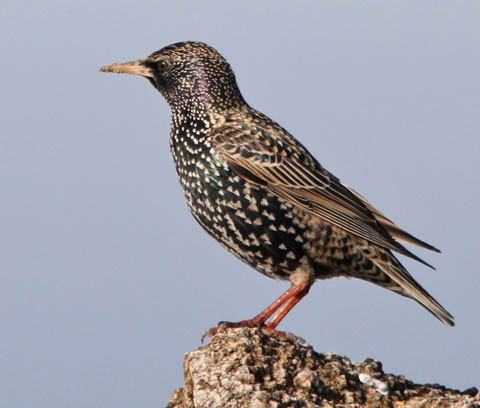
a web page by Don Roberson |
 |
STARLINGS, MYNAS & ALLIES Sturnidae |
||
|
||
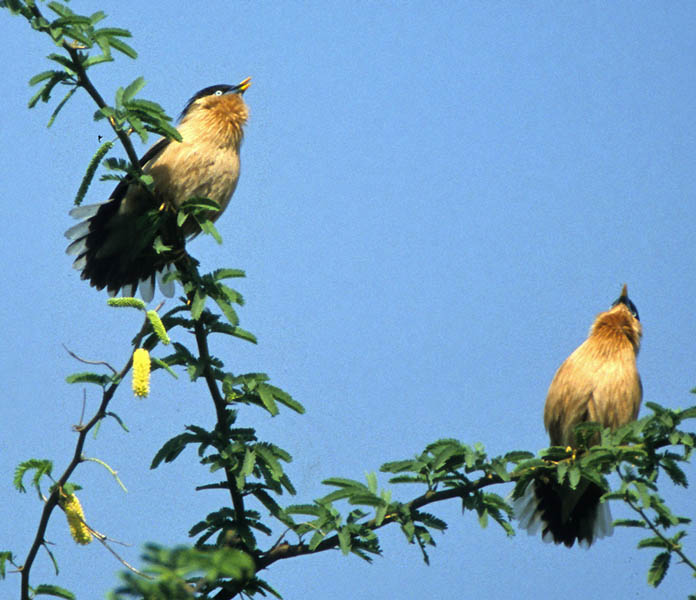 The
family Sturnidae — starlings, mynas & allies — can conjure up a
multitude of images. It might be the hordes of non-native European Starlings
blotting the sky almost anywhere in North America (above; here with
Red-tailed Hawk). It might be the wonderful dueting display of Brahminy Starling in India (left). Or it might be the dazzling iridescent colors of many starlings in Africa — such as Cape Starling
in southern Africa (below). The Sturnidae is a diverse and interesting
family. It is an Old World family, with successful colonization of many
Pacific Islands. Yet widespread introductions of several species —
notably European Starling and Common Myna — has made sturnids a part of
the avian landscape almost worldwide. They are as familiar to residents
of urban areas from New York and Hawaii to Singapore and New Zealand as
they are to visitors to tropical rainforests or African savanna. The
family Sturnidae — starlings, mynas & allies — can conjure up a
multitude of images. It might be the hordes of non-native European Starlings
blotting the sky almost anywhere in North America (above; here with
Red-tailed Hawk). It might be the wonderful dueting display of Brahminy Starling in India (left). Or it might be the dazzling iridescent colors of many starlings in Africa — such as Cape Starling
in southern Africa (below). The Sturnidae is a diverse and interesting
family. It is an Old World family, with successful colonization of many
Pacific Islands. Yet widespread introductions of several species —
notably European Starling and Common Myna — has made sturnids a part of
the avian landscape almost worldwide. They are as familiar to residents
of urban areas from New York and Hawaii to Singapore and New Zealand as
they are to visitors to tropical rainforests or African savanna. |
||
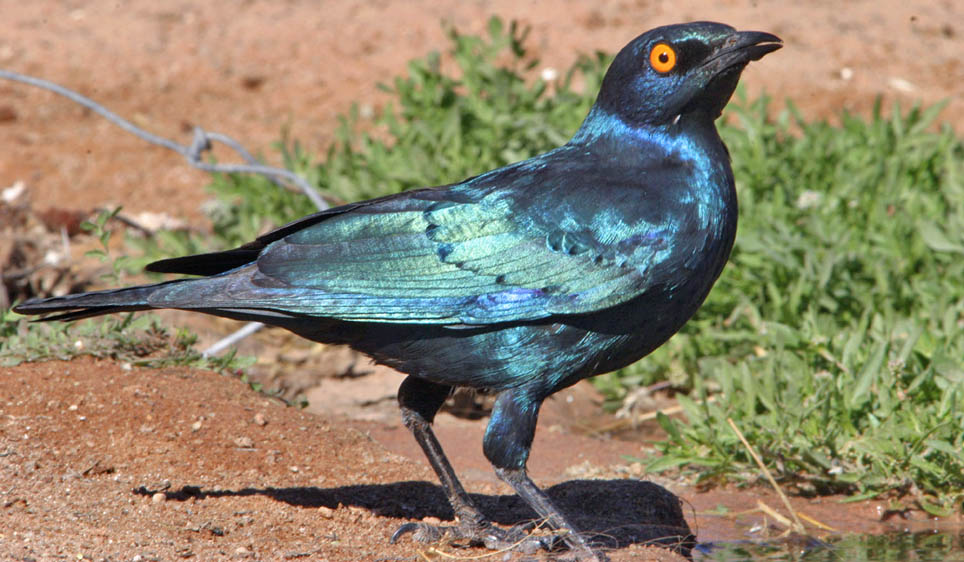 |
||
 |
||
|
||
 |
||
Africa has another seven or so genera with divergent species (plus there is Madagascar Starling Saroglossa aurata on that island), and one of those is the lovely Violet-backed Starling (below). Sometimes called "Amethyst Starling," it has a wide range in African woodlands. Unlike most African starlings, there is strong sexual dimorphism. This one (below) is a male in miombo woodlands in the Caprivi Strip, Namibia. |
||
 |
||
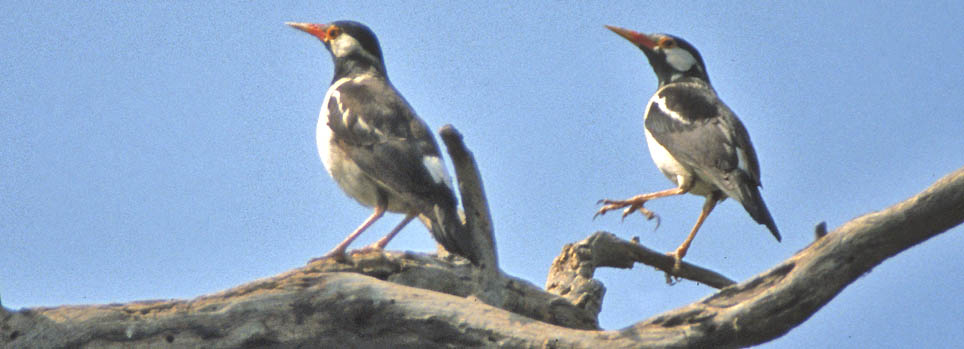 |
||
|
||
An abundant and widespread myna in south Asia — and one that has been introduced widely elsewhere — is Common Myna (right). It is a large chunky bird with extensive bare skin around the eye; white wing patches in flight; and a wide array of vocal mimicry. A fair number of the Sturnidae can mimic the calls of other birds or of man-made noises, and incorporate these into their song repertoire. |
||
There are four strange and elusive mynas that are endemic to Sulawesi, and a fifth is on nearby Banggai and Sula islands (Helmeted Myna Basilornis galeatus). Shown below are three of these species:
An exotic and extraordinary myna is Apo Myna Goodfellowia miranda, a slim, bare-faced, short-crested, long-tailed endemic to the highest elevations on Mt. Apo and Mt. Katanglad, Mindanao, the Philippines. |
||
|
||
 |
||
Where it is non-native, European Starling is the bane of the local avian world. It is a pretty enough bird and has some engaging behaviors, but unfortunately its burgeoning population has devastated locally hole-nesting native species. Do you recall the old political machine in Chicago, where they urged residents to "vote early and often"? Starlings don't vote... but they breed. And they breed early and often They like to use old woodpecker holes (right) and have often taken the best sites by late March before nesting swallows or Purple Martins arrive. They are also aggressive, and will drive a Hairy Woodpecker from a newly excavated site. Breeding Bird Atlas data shows that most pairs have two broods of 2-5 youngsters each year. In North America, Starlings were introduced from Europe to New York City in 1890. This misguided introduction "took" and birds rapidly spread across industrialized America. Starlings first reach California in 1952 and were recorded in Carmel Valley by June 1953. Today, starlings breed everywhere in Monterey County (my home county) except for the remote canyons on the Big Sur coast and at higher elevations in the Ventana Wilderness. Starlings are responsible for the extirpation of Purple Martins from the Monterey Peninsula by 1957 and in Carmel Valley by 1966. |
||
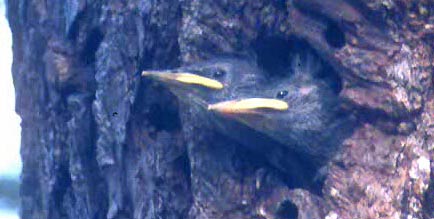 European
Starlings do not have complex plumage stages. Youngsters in the nest
(left) are uniformly gray with broad yellow gular flanges. The flanges
retract after fledging but the retained juvenal plumage is all gray,
and they have a black bill. Juvenal plumage is not held for long (just
a month) and is replaced by a complete molt once the youngster is
abandoned by their parents (juvenile in molt shown below left). The
fresh adult is glossy black and spotted heavily, with a yellow bill
(below right). These spots wear away over time and by spring the spots
are gone, leaving the glossy-black plumage in which they breed. European
Starlings do not have complex plumage stages. Youngsters in the nest
(left) are uniformly gray with broad yellow gular flanges. The flanges
retract after fledging but the retained juvenal plumage is all gray,
and they have a black bill. Juvenal plumage is not held for long (just
a month) and is replaced by a complete molt once the youngster is
abandoned by their parents (juvenile in molt shown below left). The
fresh adult is glossy black and spotted heavily, with a yellow bill
(below right). These spots wear away over time and by spring the spots
are gone, leaving the glossy-black plumage in which they breed. |
||
|
||
Rhabdornises have traditionally been considered a separate family allied to the Certhiidae (treecreepers), and were once called "Philippine creepers." Traditional paintings of Rhabdornises (e.g., Austin & Singer 1961, du Pont 1971) show them clinging to tree trunks like traditional creepers. While they sometimes forage along a limb, checking crevices, they mostly do so by hopping, and the rest of their behavior is not particularly creeper-like. They often forage in mixed species flocks, with tits or small babblers, or sit up in bare trees like starlings (left). They have brush-tipped tongues for flower feeding, and have a varied diet (e.g., insects, fruit, tree-frogs; Kennedy et al. 2000). DNA sequencing found them to be most closely related to starlings (Cibois & Cracraft 2004). Indeed, following the approach of Sibley & Ahlquist (1990), that new research treats them simply as a tribe among the starling family. It turns out that Rhabdornis is more closely related to starlings than are the oxpeckers (Buphagus) that have long been considered to be starlings (Cibois & Cracraft 2004). Now, every global family lists considers the Rhabdornises to be embedded with the Sturnidae, and it is the Oxpeckers that now have their own family [Buphagidae]. All of the Rhabdornis have a black mask, gray crown, and streaking to the sides but they differ in facial and crown details, breast pattern, and the crispness of the side streaking. The largest, most impressive, and rarest species in the family is Long-billed Rhabdornis, sometimes called "Grand Rhabdornis" (below in a fine shot by Blake Matheson; I aimed my camera at this bird but Blake's photo is better). Long-billed Rhabdornis is restricted to montane forests in northern Luzon where it usually occurs singly. We first picked this bird up in an undulating flight, and tentatively called it a "Mountain Shrike!" It is about that size and has a heavy, long bill for this genus. Although mostly thought of as a high elevation species, we recorded it in mixed species flocks down to 1000m elevation in the Sierra Madre on northern Luzon. Sometimes those flocks also contained one or more Stripe-sided Rhabdornis. |
||
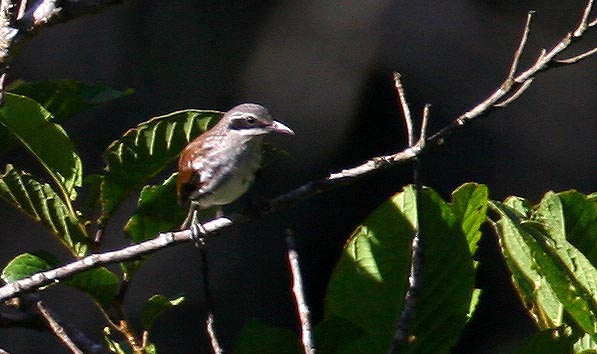 |
||
Photos: The flock of European Starling Sturnus vulgaris was near Salinas, California, on 9 Aug 2014. The dueting pair of Brahminy Starling Sturnia pagodarum were at Bharatpur, Rajasthan, India, in March 2001. The Cape Starling Lamprotornis nitens was at Kalahari NP, South Africa, in July 2005. The Burchell's Starling Lamprotonris australis was . The Superb Starling Lamprotornis splendidus was at Tarangire NP, Tanzania, on 5 Aug 2002. The Splendid Starling Lamprotornis splendidus was at Kakum NP, Ghana, on 2 Dec 2013. The Red-winged Starling Onychognathus morio (both shots) were at Cape of Good Hope, South Africa, in July 2005, and the Pale-winged Starling O. nabouroup was at Augrabes Falls NP, South Africa, that same month. The Violet-backed Starling Cinnyricinclus leucogaster in the Caprivi Strip, Namibia, on 23 July 2005. The two Asian Pied Starling Gracupica contra were at Bharatpur, Rajasthan, India, in March 2001. The Black-winged Starling Acridotheres melanopterus was at Bali Barat NP, Bali, Indonesia, in Sep 1988. The painting of Bali Myna Leucopsar rothschildi is by Frank Jarvis from Birds of Bali (1989) by Mason & Jarvis (Periplus Editions). The Common Myna Acridotheres tristis was at Bueng Boraphat, Thailand, on 31 Dec 2012. The Great Myna Acridotheres grandis was at Bueng Boraphat, Thailand, on 31 Dec 2012. The Fiery-browed Myna Enodes erythrophris was at Lore Lindu NP, Sulawesi, Indonesia, on 8 Sep 2011. The Sulawesi Myna Basilornis celebensis was at Karaenta Forest, Sulawesi, on 26 Sep 2011. The White-necked Myna Streptocitta albicollis was at Dumago Bone NP, Sulawesi, on 4 Oct 2011. The shots of non-native European Starling Sturnus vulgaris at nest hole and youngsters in the nest were taken 5 June 2002 in Pacific Grove, California; the molting juv was in Pebble Beach on 26 Jul 2014 and the fresh adult at Pt. Pinos on 14 Jan 2012. The Stripe-sided Rhabdornis Rhabdornis mystacalis was in the PICOP forest lands, south of Bislig, Mindanao, Philippines, on 26 Dec 2005. Blake Matheson photographed the Long-billed Rhabdornis Rhabdornis grandis on Mt. Pollis, Philippines, on 1 Jan 2006. Uncredited photos © Don Roberson. Credited photos © Blake Matheson, as credited, and used with permission; all rights reserved. Family book:
Literature cited:
|
 Starlings reach their dazzling prime in sub-Saharan Africa. Genus Lamprotornis
has the most species (23) of African starlings, most of them heavily
glossed in blue or green. Some are long-tailed and glossed throughout
the plumage, such as Burchell's Starling of southern
Africa (above). Others have more normal tail length but lots of glossy
iridescence, including two with jaw-breaking English names such as
Lesser Blue-eared Starling L. chloropterus and Greater Blue-eared Starling L. chalybaeus. Some include a mix of other bright colors in their plumage, such as Superb Starling
(left) of east Africa. Many of these species are birds of savanna,
woodland edges, grasslands, or thornscrub. Some, however, are forest
species, such as Splendid Starling (below) of forested lowlands in west and central Africa.
Starlings reach their dazzling prime in sub-Saharan Africa. Genus Lamprotornis
has the most species (23) of African starlings, most of them heavily
glossed in blue or green. Some are long-tailed and glossed throughout
the plumage, such as Burchell's Starling of southern
Africa (above). Others have more normal tail length but lots of glossy
iridescence, including two with jaw-breaking English names such as
Lesser Blue-eared Starling L. chloropterus and Greater Blue-eared Starling L. chalybaeus. Some include a mix of other bright colors in their plumage, such as Superb Starling
(left) of east Africa. Many of these species are birds of savanna,
woodland edges, grasslands, or thornscrub. Some, however, are forest
species, such as Splendid Starling (below) of forested lowlands in west and central Africa.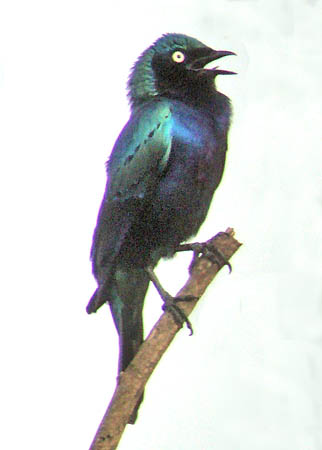
 Another set of African starlings as the "red-winged" starlings in genus Onychognathus. The most common and widespread of this set is Red-winged Starling
(above and right), a bird of rocky outcrops, gorges, and highlands, but
now adapted to some urban habitats as well. Starlings in this genus (11
species) have a glossy black plumage and an extensive red or orange
wing patch covering much of the base of the primaries. This patch can
be hidden when perched but is very conspicuous in flight. Many have
medium to long tails — Waller's Starling O. walleri of east Africa and Bristle-crowned Starling O. salvadorii
of rocky highlands in Ethiopia and vicinity are particularly
long-tailed — but others have short and rather square-tipped tails. One
of those is Pale-winged Starling (below). It inhabits arid rocky regions in southwest Africa. Its wing patch is whitish with a pale orange tinge.
Another set of African starlings as the "red-winged" starlings in genus Onychognathus. The most common and widespread of this set is Red-winged Starling
(above and right), a bird of rocky outcrops, gorges, and highlands, but
now adapted to some urban habitats as well. Starlings in this genus (11
species) have a glossy black plumage and an extensive red or orange
wing patch covering much of the base of the primaries. This patch can
be hidden when perched but is very conspicuous in flight. Many have
medium to long tails — Waller's Starling O. walleri of east Africa and Bristle-crowned Starling O. salvadorii
of rocky highlands in Ethiopia and vicinity are particularly
long-tailed — but others have short and rather square-tipped tails. One
of those is Pale-winged Starling (below). It inhabits arid rocky regions in southwest Africa. Its wing patch is whitish with a pale orange tinge. 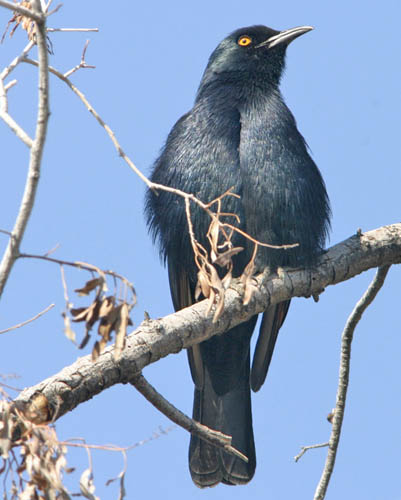
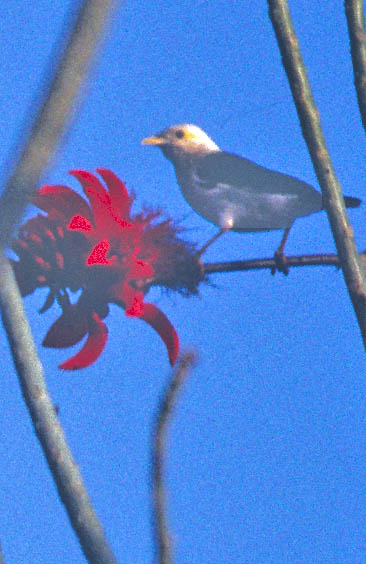 Turning to Asia, there are 20 genera, including Gracupica with just two species, one of them Asian Pied Starling
(above). Ten of those genera include species that are called mynas, and
the border between "starling" and "myna" has been fuzzy for a very long
time. Black-winged Starling of Java and Bali, Indonesia (right) is in genus Acridotheres, many of which are termed "Myna." Indeed, Feare & Craig call it "Black-winged Myna, " as does the Handbook of the Birds of the World (Craig & Feare 2009). However, most species called "Myna" have a crest of some sort — including many Acridotheres
— and I'm content with Black-winged Starling. In the forest at the
northwest tip of Bali, the flocks of Black-winged Starling are
sometimes joined by one of the world's great species: Bali Myna. I saw
a wild Bali Myna there in Sep 1988 — just handful still survived and
before captive breeding and reintroductions schemes had begun. Bail Myna is very much an impressive and regal species — I chose it among my list of "
Turning to Asia, there are 20 genera, including Gracupica with just two species, one of them Asian Pied Starling
(above). Ten of those genera include species that are called mynas, and
the border between "starling" and "myna" has been fuzzy for a very long
time. Black-winged Starling of Java and Bali, Indonesia (right) is in genus Acridotheres, many of which are termed "Myna." Indeed, Feare & Craig call it "Black-winged Myna, " as does the Handbook of the Birds of the World (Craig & Feare 2009). However, most species called "Myna" have a crest of some sort — including many Acridotheres
— and I'm content with Black-winged Starling. In the forest at the
northwest tip of Bali, the flocks of Black-winged Starling are
sometimes joined by one of the world's great species: Bali Myna. I saw
a wild Bali Myna there in Sep 1988 — just handful still survived and
before captive breeding and reintroductions schemes had begun. Bail Myna is very much an impressive and regal species — I chose it among my list of "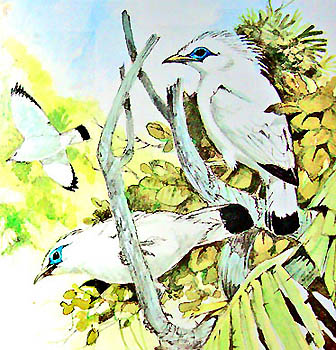
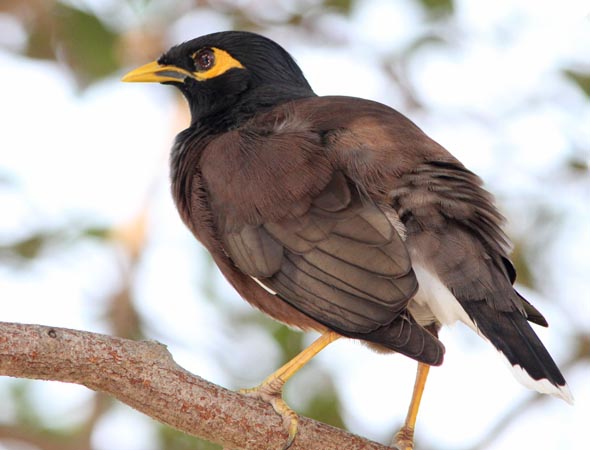
 Several of the mynas do have an impressive crest; an example is Great Myna (right). It ranges from southeast Asia to Sumatra and Java. The largest mynas are the various hill mynas in genus Gracula, scattered from India and Sri Lanka to the Greater Sundas.
Several of the mynas do have an impressive crest; an example is Great Myna (right). It ranges from southeast Asia to Sumatra and Java. The largest mynas are the various hill mynas in genus Gracula, scattered from India and Sri Lanka to the Greater Sundas. 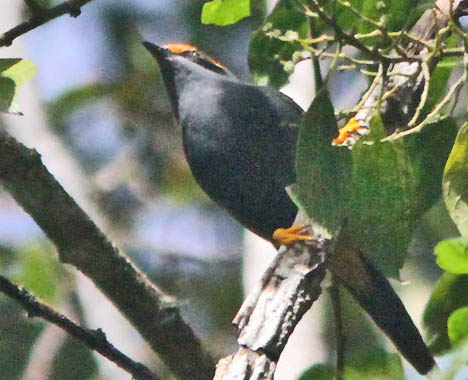
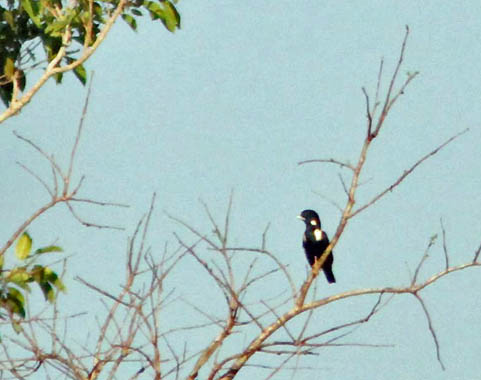
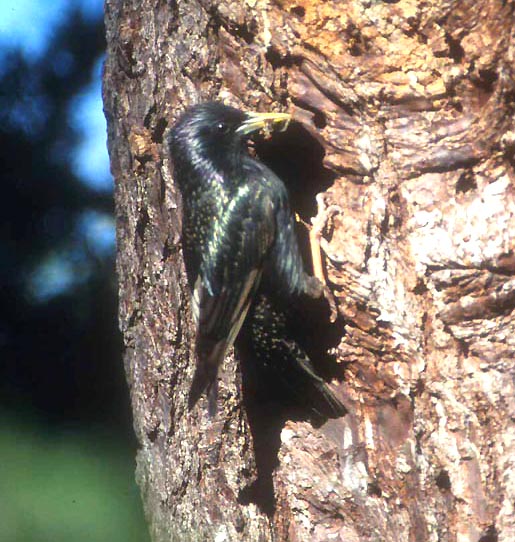 Now we move from the distant and exotic to the mundane and widespread, the genus Sturnus. Currently is is composed on only two species: Spotless Starling Sturnus unicolor
of southern Europe and northwest Africa, and European Starling. As a
native species European Starling breeds from the U. K. and Scandinavia
to Lake Baikal, Russia, and winters from southern Europe to north
Africa, the Middle East, and Pakistan. It is, however, introduced and
now abundant across North America, some of the Caribbean, southern
Africa, southeast Australia, New Zealand, and Polynesia. Sadly enough,
the non-native European Starling nests in my backyard (right).
Now we move from the distant and exotic to the mundane and widespread, the genus Sturnus. Currently is is composed on only two species: Spotless Starling Sturnus unicolor
of southern Europe and northwest Africa, and European Starling. As a
native species European Starling breeds from the U. K. and Scandinavia
to Lake Baikal, Russia, and winters from southern Europe to north
Africa, the Middle East, and Pakistan. It is, however, introduced and
now abundant across North America, some of the Caribbean, southern
Africa, southeast Australia, New Zealand, and Polynesia. Sadly enough,
the non-native European Starling nests in my backyard (right). 
